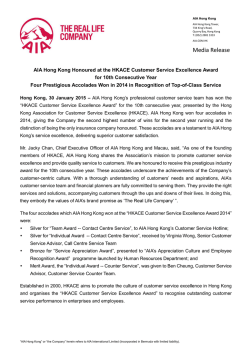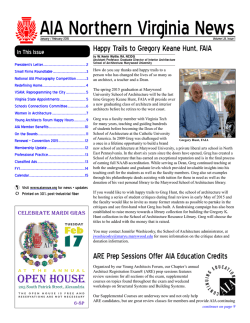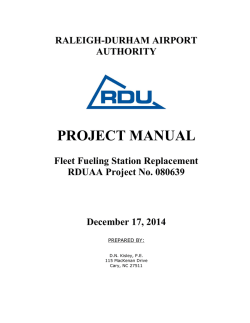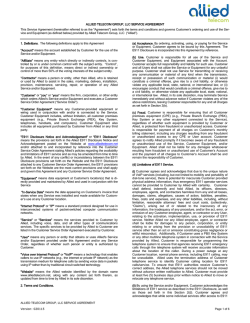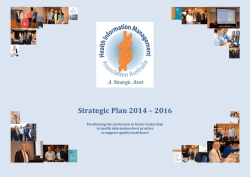
2010 2015 StrAtegIc PlAn - American Institute of Architects
2010 ➡ 2015 Strategic Plan The American Institute of Architects Driving positive change through the power of design AIA THE AMERICAN INSTITUTE OF ARCHITECTS 2010–2015 AIA Strategic Plan 1 2010–2015 AIA Strategic Plan From Where We’ve Come In 1999, the AIA began a planning process that resulted in The AIM Report: A Strategic Long-Range Plan for The American Institute of Architects. Aligning the Institute for the Millennium (AIM) established a mission and vision for the AIA, along with core values and major objectives. In 2002, the AIA developed a strategic plan in response to AIM that served as a bridge between the initial AIM principles and the strategies articulated in the 2002 strategic plan. Subsequently, the strategic plan was updated in 2004, 2005, and 2006. The strategic plan developed in 2006 included a new mission statement and four overarching goals: • Increase member value • Be the authoritative source • Serve as the credible voice • Optimize organizational performance In addition, the plan incorporated for the first time metrics for measuring success in implementing the strategies of the plan. The 2007–2009 National Component Strategic Plan was implemented in January 2007. Because the environment does not remain static, the plan was updated based on organizational performance to date, data and industry trends gleaned from the annual Environmental Scan, the internal scan, and the market and member research conducted to assess the AIA’s performance on measures of member satisfaction and other performance indicators. The plan was fine-tuned and updated to reflect what has been learned so far and to respond to the new challenges and opportunities that the organization and its members are expected to face in the current and future environment. 2010–2015 AIA Strategic Plan 2 As with previous plans, the 2008-2010 National Component Strategic Plan focused on the goals, strategies, and metrics of the national component. However, the national component remained committed to collaborating with local and state components and to providing resources for their use. Therefore, state and local components were encouraged to utilize the national component plan as a model for developing their own strategic plans. In 2009, the AIA Board of Directors embarked on a year-long process to set the strategic outlooks for the Institute for the next five years. Guided by eight principles identified in the 2008-2010 plan update—focus, flexibility, ethics, technology, relevance, connection, access, and innovation—the Board Strategic Direction Group, the process began with a series of scans of the architecture profession and the environment that influences it. Next, the Board met in July 2009 in Washington, D.C. for a two-day planning session in which they reviewed the feedback received from members and stakeholders, validated and reaffirmed the mission and goals, and drafted a vision statement as well as new strategies for the future. From August through October 30, 2009, there was an open comment period during which the AIA solicited input from components, members, allied organizations, and other stakeholders on the draft 2010-2015 strategic plan. The AIA held three webinars open to all members and encouraged board members to gather feedback at their regional meetings. The final version of this plan reflects the feedback from these sources. Vision The American Institute of Architects: Driving positive change through the power of design Mission The American Institute of Architects is the voice of the architectural profession and a resource for its members in service to society. 2010–2015 AIA Strategic Plan 3 Goals Serve as the Credible Voice Promote the members and their AIA as the credible voice for quality design and the built environment. Be the Authoritative Source Be the recognized leader for knowledge about the practice and profession of architecture. Increase Member Value Increase value to members through programs and services that effectively meet, anticipate, and exceed their needs. Strategies Knowledge Create, promote, and disseminate interdisciplinary study and research ensuring the AIA’s members are leaders in the profession, the industry, and their communities. Advocacy Advance policies about design through political outreach, education, and engagement that are responsive to the public and the profession. Communication Elevate the voice of architects to promote the value of design and to enhance the public’s understanding of the importance of architecture. Collaboration Align resources and empower networks of members, components, and allied professionals to build teamwork. 2010–2015 AIA Strategic Plan 4 Putting a Plan into Action: Strategic Initiatives Moving forward, every AIA component has the opportunity to connect their programs to the 2010–2015 strategic plan. This document offers a framework for planning around common categories of initiatives that enable cross-collaboration and organization of work. Those strategic initiative categories are: • Environment + Stewardship (e.g. Sustainability) • Components + Communities (e.g. Diversity + Inclusiveness, Emerging Professionals) • Technology + Innovation (e.g. Integrated Project Delivery) • Business + Practice (e.g. Global Initiatives) Tools will be developed and shared with the components at Grassroots 2010. The AIA will maintain an ongoing planning schedule so that plans are responsive to changes in the environment and member needs. The strategic plan will be revisited regularly to refine existing strategies and metrics based on organizational performance in implementing the plan. In five years, the plan will be reviewed to determine the need for changes to the goals and strategies as a result of issues identified through the ongoing assessment of the internal and external environments. 2010–2015 AIA Strategic Plan 5
© Copyright 2024
